Tell us a bit about yourself, location, present job, personal stuff.
I was born in Canada, but spent my formative years in Bahrain, Zambia and Libya, while my parents travelled for work. I finally settled down in 1989 in Canada, after going back and forth from England, where my parents are originally from. This gave me a rather strange accent that often puzzles people. So now, I've been a freelance illustrator for about 10 years having clients such as Rolling Stone, Financial Times (UK), LA Weekly, The Boston Globe, ESPN, etc. I work on these illustrations in my Hamilton studio/home just outside of Toronto in Ontario, Canada & I also teach part-time at OCAD U, Ontario College of Art & Design, in Toronto.
What inspired you to become an artist and how old were you then?
I've always really loved working on art and when I was a child I'd make cards for family & friend's birthdays. I think growing up in Middle East and travelling a bunch really got me excited about all the colour and textures around me. When I was young, I would especially love to go shopping at the souk markets in Bahrain where my eye would be attracted to the intricately decorative Persian rugs & the masses of colourful spice stalls. I think that love of pattern has always stuck with me.
Please describe your materials and medium you use in your pieces.
I specialize in hand-lettering, portraiture and nature illustrations - I love blending peculiar patterns and textures. I typically ink my work and paint with good old-fashioned oil or acrylic and elbow grease. Occasionally for commercial work, I render colour digitally, when a modern mood strikes.
Who are your favorite artists? Why?
There are certain artists that will always be so thrilling for me to look at including Rauschenberg, Bruegel, Hopper, Freud, Toulouse-Lautrec, Klimt, & Schiele. But, I also get inspired by illustrators such as Moebius & vintage comic book illustrators such as Winsor McCay. Recently I've been amazed by the colours and textures of Henrique Oliveira's large scale found-wood sculptures. My inspiration comes from more than just other artists, I also look to book cover design, vintage posters, textiles, folk art, record covers, architecture, & various old ephemera especially antique type work. Not to forget that there are certain film directors and cinematographers that will always impel my urge to paint.
What’s been your favourite project so far?
I've really enjoyed a bunch of projects I've worked on this past year or two, since recently I feel like I'm enjoying the process of creating art so much more. I just finished a series about Hawaiian Ukulele music which was so much fun & now I'm thrilled about the new animal paintings I'm doing for an art exhibit in Hamilton, entitled ZOO coming up in July.
What is a constant challenge for you and most rewarding part of having a creative profession?
It is so satisfying to work for myself and actually get paid to paint. I love having my own hours and working at home but the tricky part is the balance between work and leisure time, especially when you enjoy working so much. I have to give myself permission to stop sometimes and remind myself that it's alright and important to do other things. It's hard to do that when it's busy. Being a freelancer you never like to turn down a job, so sometimes you have to get used to working very long hours which I find harder as the years go by!
What do you do when you are not working?
When I'm not working I do love to watch films. I'm also a dancer and have taught & performed vintage jazz and Lindy Hop swing since 1990. I find this is a really great mix and forces myself to get away from hunching over my drafting table.
How do you use your blog for your art?
The blog is a fairly new venture for me. I nervously started it a few months ago, not being sure if what I had to show would interest anyone. But, since I got on my way I've really enjoyed working on it. I like to show my process for my paintings which hopefully helps other people but also forces me to scrutinize & adapt my process. I also include other things that excite and inspire me such as art, design, & film stills.
I noticed that your pieces have owls in it, and was wanting to ask you about that.
I got interested in owl paintings when a couple of friends took me on a very Canadian outing to the sugar shack festival at Mountsberg Conservation Park. I think they were trying to instill a love of the cold Canadian Winter in me! So this is a tradition in Canada where maple trees are tapped for syrup, which you eat when it freezes on the snow. At this park they also have a selection of rescued owls & eagles. I had never seen one up close and they were so striking, especially the Barn Owls with their big staring dark eyes. They had such an otherworldly quality & a quiet strength that I was dying to capture in paint.
Soon after this I had my first solo show in Toronto entitled, Prowl which focused on these owl paintings and had some beautiful owl poems by my friend and fellow owl enthusiast Carolyn Veldstra (www.thebewildered.com). This show was a sort of quirky nature tour, making connections that might have seemed farfetched, between the witticisms of Carolyn and the art. A lot of the artwork was inspired by old textile patterns and prints, and the texture of owl’s feathers really lends itself to that. Here's one of the poems from the show:
THE BARN OWLS
We see here a pair of Barn Owls—and we gain the distinct impression that we are being stared down by something preternaturally calm, nearly dangerous. These eyes, darker than an ink-dipped coal-miner, give away little of this bird’s soul, and perhaps penetrate a little too deeply in our own.
They know us well. Barn Owls live in close proximity to humans—inhabiting all our dark crannies and feasting on all that goes bump in our night. It’s not surprising that beaten down English serfs saw death in these pale white faces.
Death to voles, surely—a nesting pair of Barn Owls will eat more than 1000 voles in a season. Quick to determine that a bulbous serf (or skinny academic) is less a meal than a flurry of voles, we can rest assured the Barn Owl will most often leave well enough alone; though, keep in mind, folkish wisdom advocates walking around an owl in a tree—of course, the owl will turn and turn and turn its head to watch you, thereby wringing its own neck.
Describe your work on which you are currently working?
I'm working on a few different editorial pieces for magazines in the States and in the process of doing art for a group show myself and my husband, Jamie Lawson are curating here in Hamilton called Zoo, or a Montley Menagerie of Magnificent Mamalia, in July. This is really thrilling since it's the first time in years we've all shown our work together with our talented friends. My contribution will be a series of decorative animal images showing scenes of violence is a beautiful way.
What are your future plans and dreams?
Wow, that's a large question. I'd love to publish a book at some point either about birds or about vintage American dance. It would be lovely to work on more shows and projects that I am in charge of. I just hope as time goes by I still stay inspired by working on different artwork and travelling, but things are looking good so far.


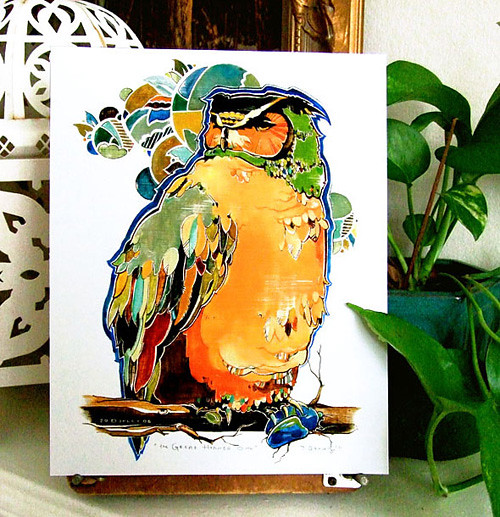
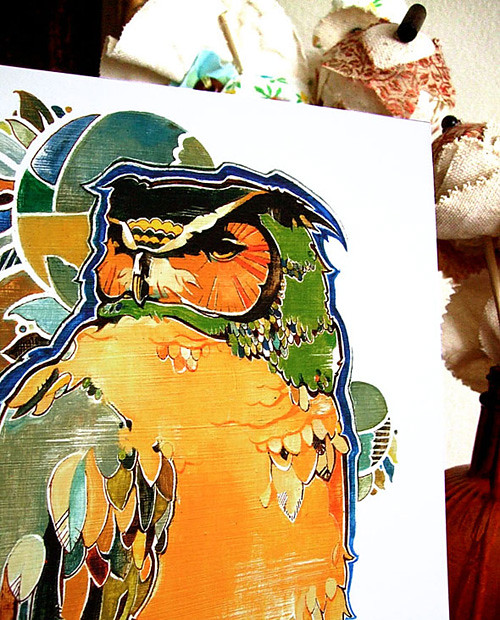
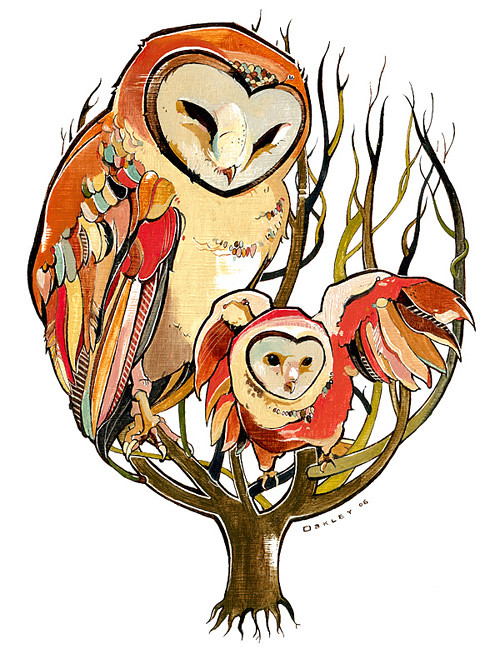
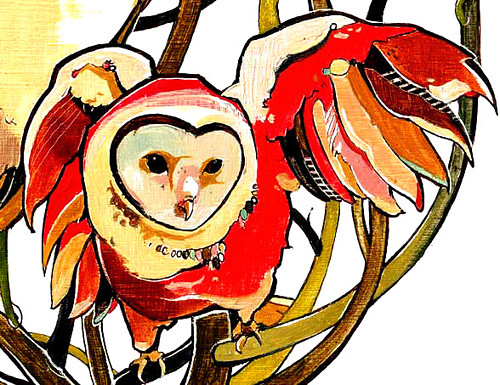
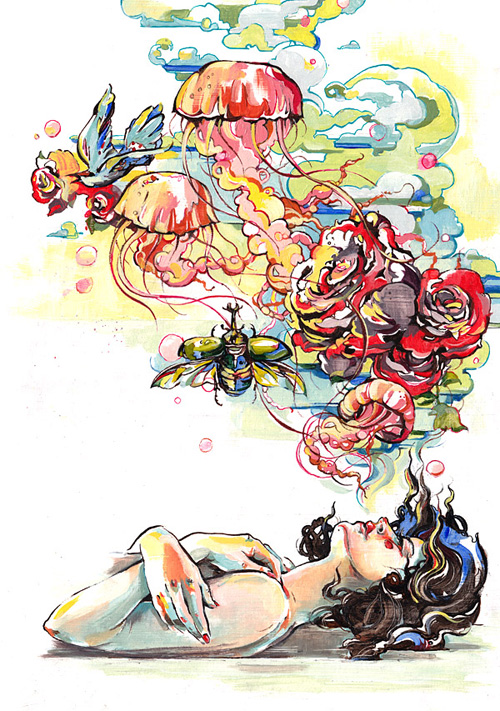




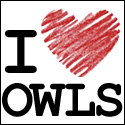

1 comments :
i love the colors in these pieces! such an inspiring interview! thank you!
Post a Comment